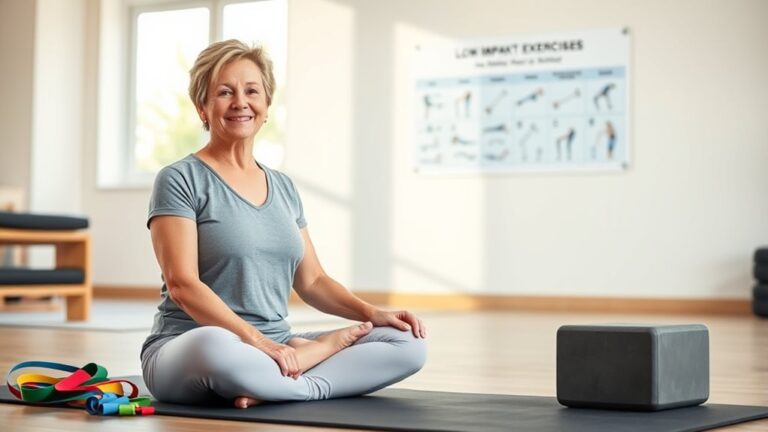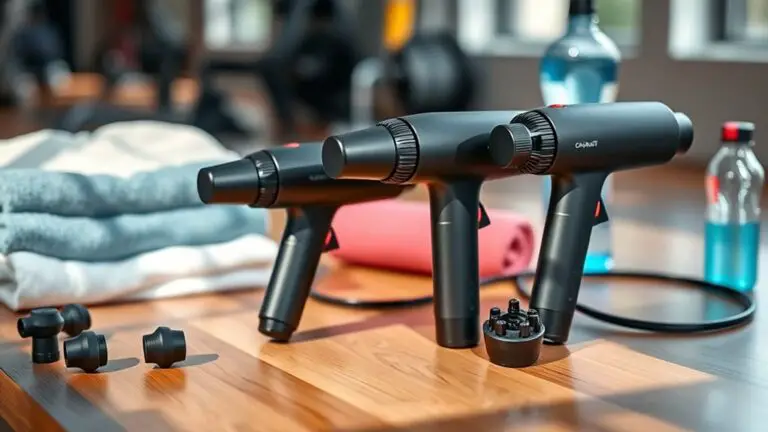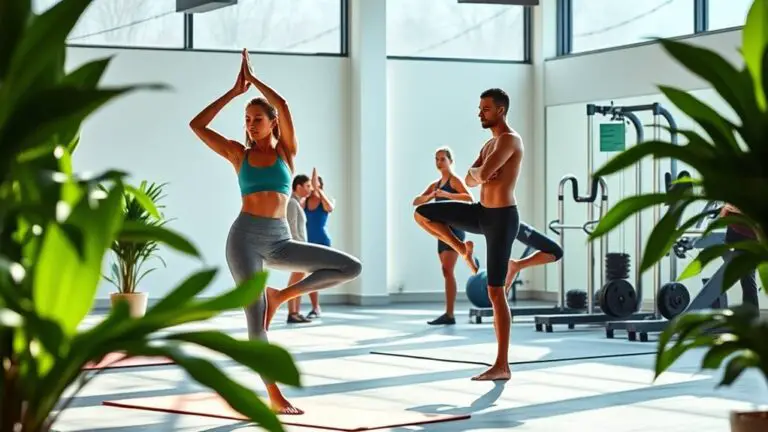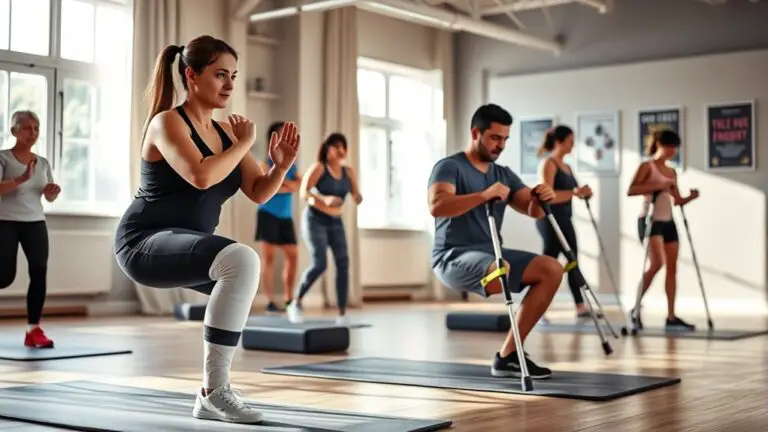The Best Gym Warm-Ups That Save Time and Prevent Injuries
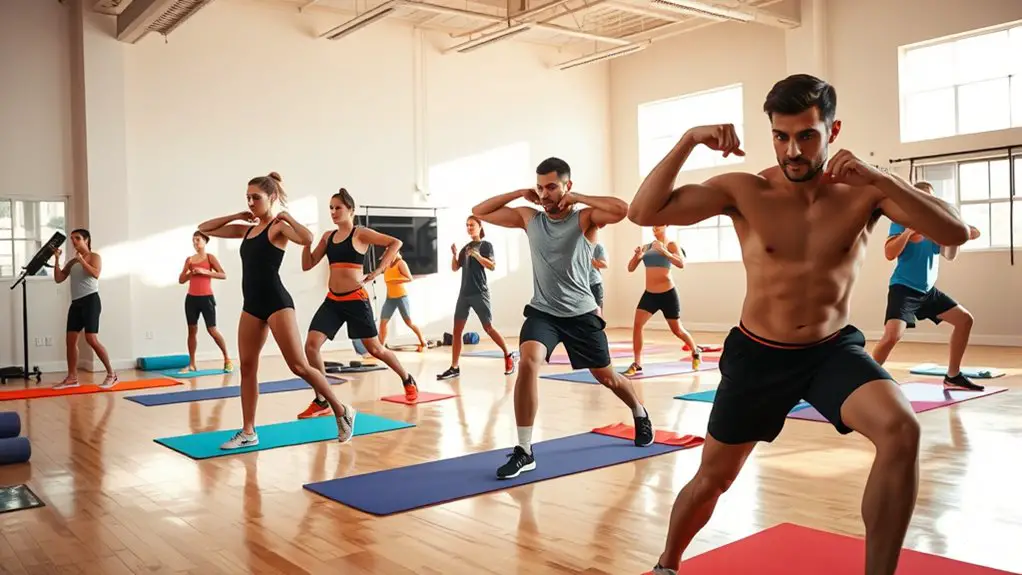
Warming up is essential for effective workouts and injury prevention. A quick routine should include dynamic stretches, like leg swings and arm circles, to enhance mobility. Foam rolling helps release muscle tension and improve flexibility, while cardio warm-ups—like jumping jacks and high knees—get your heart pumping. Incorporating sport-specific movements guarantees you’re ready for your workout. Finally, focus on proper breathing to maximize performance. Discover more techniques to create a personalized warm-up routine that fits your goals!
The Importance of Warming Up Before Workouts
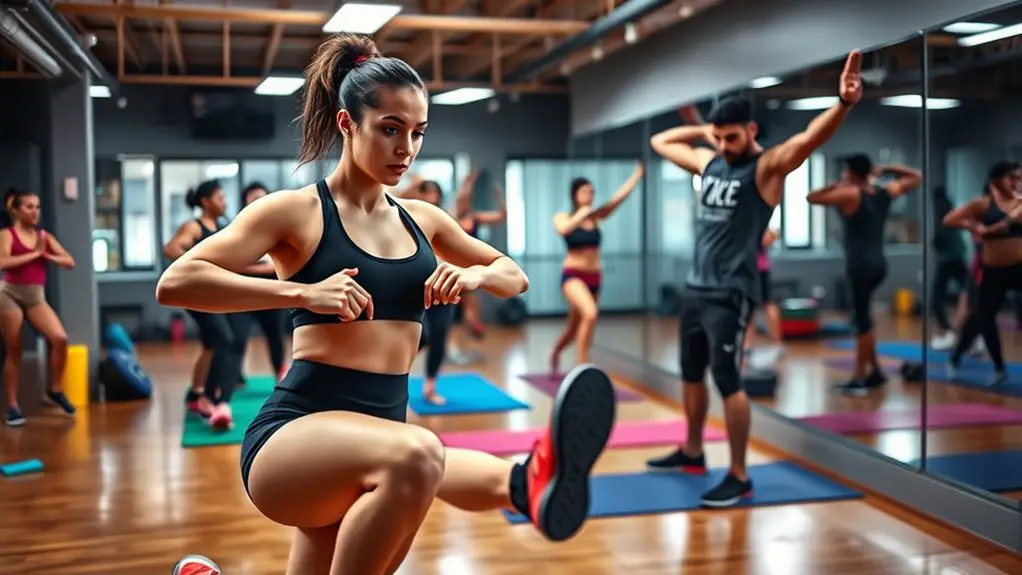
When you immerse yourself in a workout without warming up, you risk injury and undermine your performance. Warming up is essential for injury prevention; it gradually increases your heart rate and blood flow to muscles, preparing your body for the demands of exercise. Skipping this step can lead to strains, sprains, and other setbacks that sideline your fitness goals.
Additionally, a proper warm-up enhances workout efficiency. By activating your muscles and joints, you improve your range of motion and coordination, allowing for more effective movements during your workout. This means you’ll get more out of your training sessions, whether you’re lifting weights, running, or engaging in any other activity.
Incorporating a warm-up into your routine takes just a few minutes but pays off greatly. So, don’t overlook this vital step—your body will thank you, and you’ll be on your way to reaching your fitness aspirations safely and effectively.
Dynamic Stretching: The Key to Mobility
Incorporating dynamic stretching into your warm-up routine greatly enhances your mobility and prepares your body for exercise. Unlike static stretching, dynamic flexibility focuses on controlled movements that increase range of motion and blood flow. Think of mobility drills like leg swings, arm circles, and walking lunges; they activate your muscles and joints, reducing the risk of injury.
These movements mimic the actions you’ll perform during your workout and help improve overall performance. By engaging in dynamic stretching, you’re not only warming up but also enhancing your body’s responsiveness. Aim to include 5-10 minutes of mobility drills before each session to maximize their benefits. Additionally, incorporating activities like jump rope can further elevate your heart rate and warm up your muscles effectively.
As you progress, you’ll notice improved agility and a greater ease of movement, allowing you to tackle more intense workouts with confidence. So, make dynamic stretching a staple in your warm-up and release your full potential in the gym!
Foam Rolling: Preparing Your Muscles
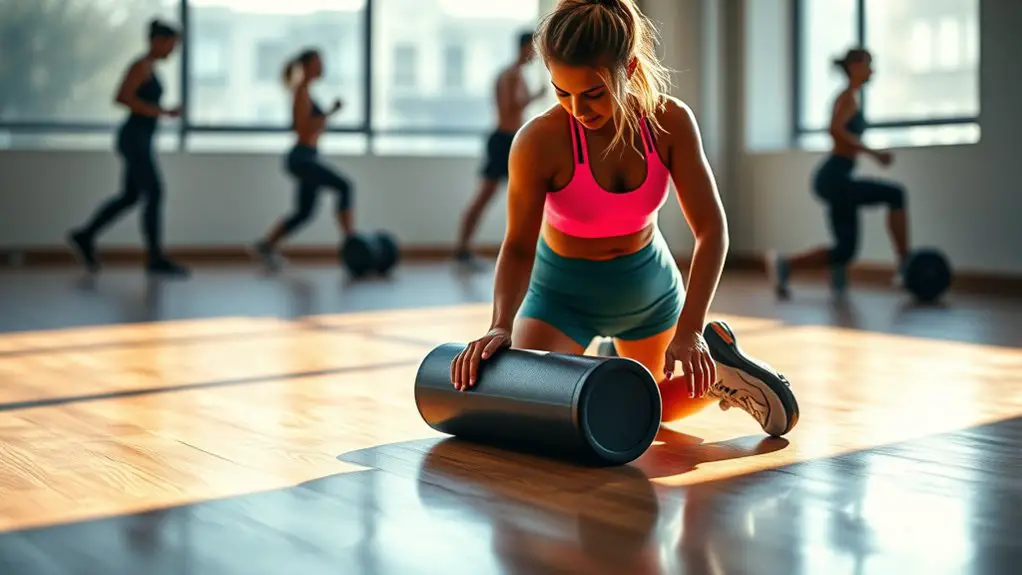
Foam rolling is a game-changer for preparing your muscles before a workout. By using effective foam rolling techniques, you can enhance muscle recovery and improve your performance. This self-myofascial release method helps to loosen tight muscles and improve blood flow, setting you up for success.
Consider these key benefits of foam rolling:
- Increases flexibility: Regular foam rolling can help you achieve a greater range of motion.
- Reduces muscle soreness: It aids in flushing out toxins and promotes faster recovery post-exercise.
- Prevents injuries: By addressing muscle knots and tension, you’re less likely to experience strains or sprains.
Incorporating foam rolling into your warm-up routine not only prepares your muscles but also enhances your overall workout experience. Make it a priority, and you’ll notice the difference in both performance and recovery.
Cardio Warm-Ups: Getting Your Heart Pumping
A solid cardio warm-up can make all the difference in your workout performance, and it should last around 5 to 10 minutes. By engaging in high intensity intervals, you’ll elevate your heart rate, preparing your body for the challenges ahead. This method effectively warms up your muscles and boosts your overall endurance. Skipping rope is an effective way to burn calories before your workout.
Here’s a quick guide to some effective cardio warm-ups:
| Warm-Up | Duration |
|---|---|
| Jumping Jacks | 1 minute |
| High Knees | 1 minute |
| Butt Kicks | 1 minute |
| Mountain Climbers | 1 minute |
| Skaters | 1 minute |
Incorporating these exercises into your routine not only saves time but reduces the risk of injury, ensuring you’re ready to tackle your workout. So, get that heart pumping and enjoy the benefits of a well-prepared body!
Sport-Specific Warm-Ups: Tailoring to Your Workout

When it comes to getting the most out of your workout, tailoring your warm-up to your specific sport is essential. By identifying key movements and incorporating sport-specific dynamic stretches, you’ll effectively prepare your body for the demands ahead. Focusing on the relevant muscle groups not only enhances performance but also helps prevent injuries.
Identify Key Movements
To maximize your performance and prevent injuries, it’s essential to identify key movements that align with your specific sport or workout routine. Conducting a key movement analysis helps you understand your body’s functional movement patterns, guaranteeing you target the right areas during warm-ups.
Consider the following when tailoring your warm-up:
- Focus on sport-specific skills: Incorporate movements that mimic the actions you’ll perform during your workout.
- Address mobility and stability: Confirm your warm-up enhances both flexibility and strength in critical areas.
- Gradually increase intensity: Start with low-impact movements and progress to more dynamic actions to prepare your body effectively.
Sport-Specific Dynamic Stretches
Incorporating sport-specific dynamic stretches into your warm-up routine can greatly enhance your performance and reduce the risk of injury. By focusing on sport-specific drills, you prepare your body for the athletic movements required in your chosen activity. For instance, if you’re a soccer player, include high knees and lateral lunges to engage your hip flexors and quads, essential for kicking and sprinting. Basketball players can benefit from dynamic stretches like arm circles and leg swings to improve mobility and coordination. Tailoring your warm-up to mimic the movements you’ll perform during the game not only boosts your readiness but also helps prevent strains. So, make these dynamic stretches a fundamental part of your workout preparation!
Focus on Muscle Groups
While preparing for your workout, focusing on specific muscle groups can considerably enhance your performance and reduce the likelihood of injury. Targeting the muscles you’ll use during your session promotes effective muscle activation, ensuring they’re ready for action. This tailored approach not only optimizes your workout but also emphasizes injury prevention.
- Identify the primary muscle groups involved in your routine.
- Use dynamic stretches and movements to warm up those areas.
- Gradually increase intensity to enhance blood flow and flexibility.
Joint Rotations: Enhancing Flexibility
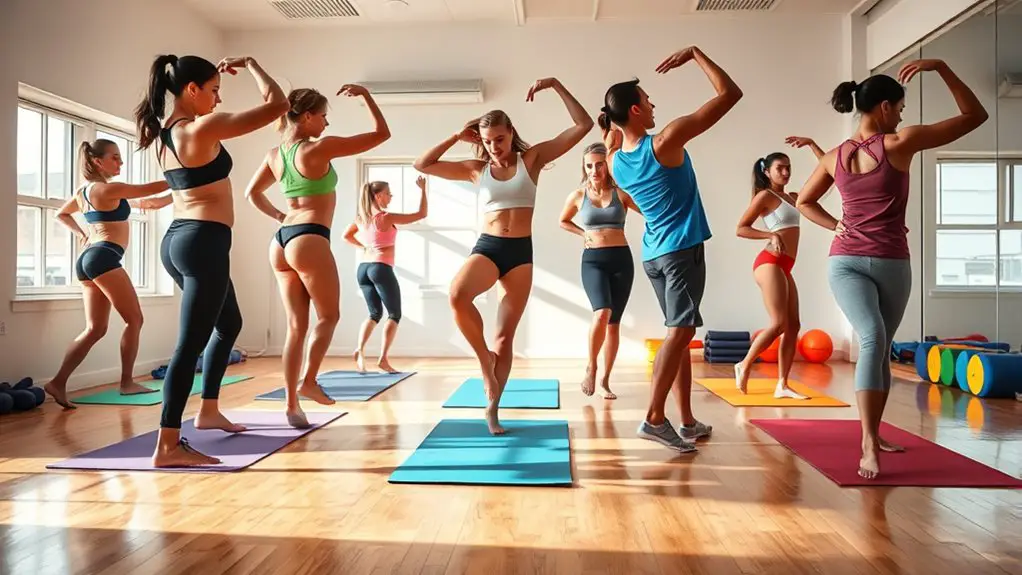
As you prepare for your workout, incorporating joint rotations can greatly enhance your flexibility and range of motion. These movements focus on improving joint mobility, making them essential for any warm-up routine. By gently rotating your joints—like shoulders, hips, and wrists—you’ll increase blood flow and reduce stiffness, setting the stage for better performance.
Start with small circles, gradually increasing the size as you feel more comfortable. This method not only warms up your joints but also engages surrounding muscles, which amplifies flexibility benefits. Aim for 10-15 rotations in each direction, ensuring that you’re maintaining a smooth and controlled motion.
Incorporating joint rotations into your warm-up can help prevent injuries and improve overall athletic performance. So, before diving into your main workout, take a few minutes to prioritize your joints; your body will thank you for it!
Bodyweight Exercises: Activating Major Muscle Groups
After you’ve warmed up your joints, it’s time to activate those major muscle groups with bodyweight exercises. These movements not only enhance your strength but also prepare your body for more intense workouts. Two key exercises to include are bodyweight squats and push-up variations.
- Bodyweight squats engage your quads, hamstrings, and glutes, improving lower body strength.
- Push-up variations target your chest, shoulders, and triceps, offering versatility to challenge your upper body.
- Incorporating these exercises boosts your heart rate, further priming your body for action. Additionally, consider adding alternative exercises that can complement your workout routine and help target different muscle groups.
Resistance Band Drills: Building Strength and Stability
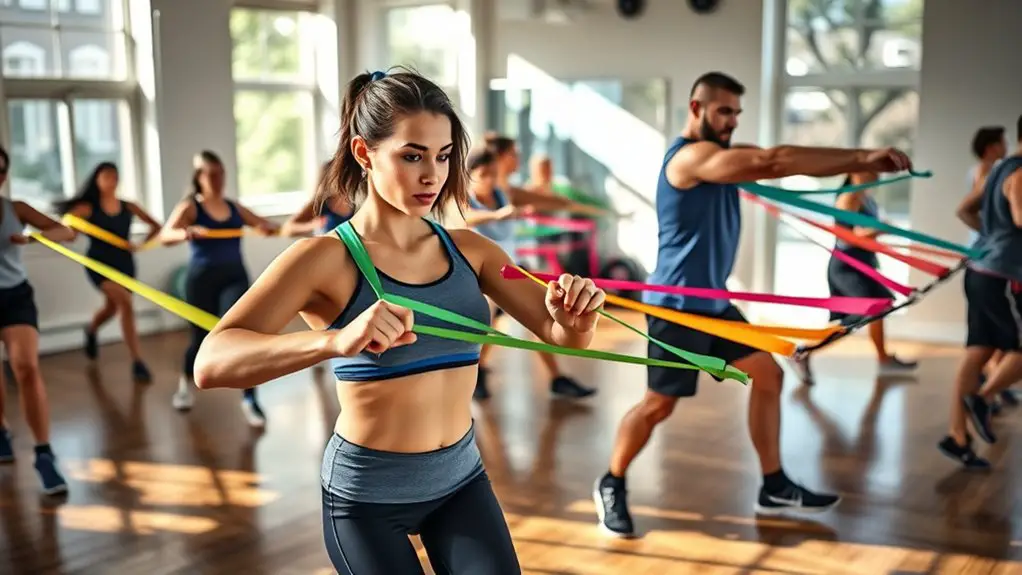
Resistance band drills are a fantastic way to build strength and stability, especially when you’re looking to enhance your workout routine without heavy weights. These versatile tools provide adjustable band resistance, allowing you to tailor your exercises to your fitness level.
Incorporating resistance bands into your warm-up can improve muscle activation and joint stability, preparing your body for more intense workouts. Start with exercises like banded squats or lateral band walks to engage your legs and core. You can also try band rows to strengthen your back and shoulders, which is crucial for maintaining proper form during other lifts.
The Role of Breathing in Warming Up
Though often overlooked, proper breathing plays an essential role in warming up your body for exercise. By focusing on breath control and utilizing diaphragmatic breathing, you can enhance your warm-up routine and better prepare your muscles for action. Here’s why it matters:
Proper breathing is crucial for warming up your body and optimizing your exercise performance.
- Increases oxygen flow: Proper breathing techniques guarantee your muscles receive the oxygen they need to perform effectively.
- Enhances focus: Controlled breathing helps you concentrate, allowing you to mentally prepare for your workout.
- Reduces tension: Deep breathing promotes relaxation, decreasing the risk of injuries by easing your muscles.
Incorporating these breathing techniques during your warm-up not only optimizes your performance but also sets a positive tone for your workout. Remember, the way you breathe can greatly influence how your body responds, so make it a priority in your routine!
Creating a Personalized Warm-Up Routine
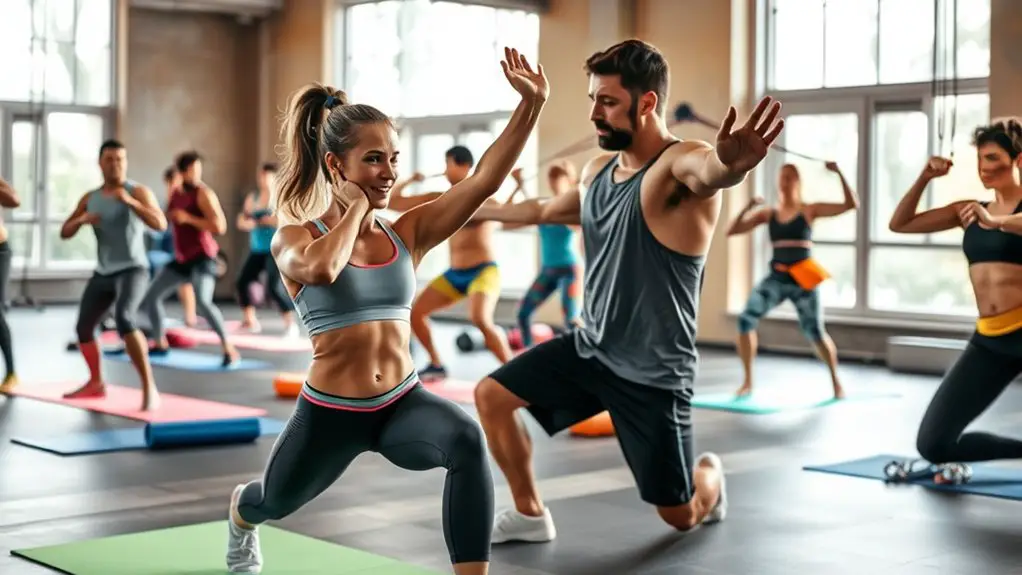
Creating a personalized warm-up routine starts with evaluating your individual fitness level to guarantee you’re targeting the right areas. Once you know where you’re at, incorporating dynamic movements can help prepare your body for the workout ahead. This tailored approach not only enhances performance but also reduces the risk of injury.
Assess Individual Fitness Level
How can you tailor your warm-up routine to suit your unique fitness level? Start with a thorough fitness evaluation to identify your strengths and weaknesses. Understanding your current capabilities allows you to create a warm-up that aligns with your personal goals.
Consider these three factors when evaluating your fitness level:
- Current fitness status: Are you a beginner, intermediate, or advanced?
- Injury history: Have you dealt with any previous injuries that may require special attention?
- Specific goals: Do you aim to build strength, improve endurance, or enhance flexibility?
Incorporate Dynamic Movements
As you develop your personalized warm-up routine, incorporating dynamic movements is essential for preparing your body for the workout ahead. Dynamic movement benefits include improved flexibility, increased blood flow, and enhanced performance. These movements activate your muscles and joints, making them vital for injury prevention.
Try exercises like leg swings, arm circles, and walking lunges to integrate mobility while engaging your core and stabilizing muscles. Focus on movements that mimic the workout you’ll be doing, ensuring your body is ready. A well-rounded dynamic warm-up should last about 5-10 minutes, allowing you to shift smoothly into your main workout. By prioritizing dynamic movements, you’ll not only save time but also enhance your overall gym experience and results.
Frequently Asked Questions
How Long Should My Warm-Up Last for Maximum Effectiveness?
Your warm-up should ideally last between 10 to 15 minutes for maximum effectiveness. This timeframe allows you to incorporate dynamic stretches that prepare your muscles and joints for activity. Focus on warm-up intensity; it should gradually increase to match the effort of your workout. By warming up properly, you enhance your performance and reduce the risk of injury, ensuring your body is ready to tackle the challenges ahead.
Can I Skip Warming up if I’m Short on Time?
You might be tempted to skip warming up when you’re short on time, but it’s not a good idea. The warm-up benefits, like increasing blood flow and preparing your muscles, are essential for injury prevention. Without it, you risk strains and sprains that could sideline you longer than a few minutes of warming up would. Prioritizing even a brief warm-up can make a big difference in your workout effectiveness and overall safety.
What Are Common Mistakes During Warm-Ups to Avoid?
Imagine stepping onto the gym floor, ready to release your potential. But hold on! Common mistakes during warm-ups can derail your progress. Avoid static stretches, which can leave your muscles cold and tight. Instead, focus on dynamic stretches that elevate your heart rate and prepare your body. Don’t skimp on warm-up intensity; it’s essential for effective preparation. Remember, a proper warm-up sets the stage for a successful workout, so don’t rush it!
How Often Should I Change My Warm-Up Routine?
You should consider changing your warm-up routine every 4 to 6 weeks. This frequency allows for enough time to adapt while also introducing variety, keeping your body engaged and preventing plateaus. Incorporating warm-up variety not only enhances your performance but also reduces the risk of injury. Listen to your body; if you notice boredom or diminishing returns, it’s a sign it’s time for a change to keep things fresh and effective.
Are There Specific Warm-Ups for Older Adults or Beginners?
Imagine a tree, strong yet flexible, adapting to the seasons. Just like that tree, your warm-up should be age-specific. For older adults or beginners, focus on gentle flexibility routines that enhance mobility without strain. Incorporate dynamic stretches and low-impact movements to prepare your body for activity. These tailored exercises not only promote safety but also build confidence, ensuring you flourish in your fitness journey, much like a tree reaching for the sun.
